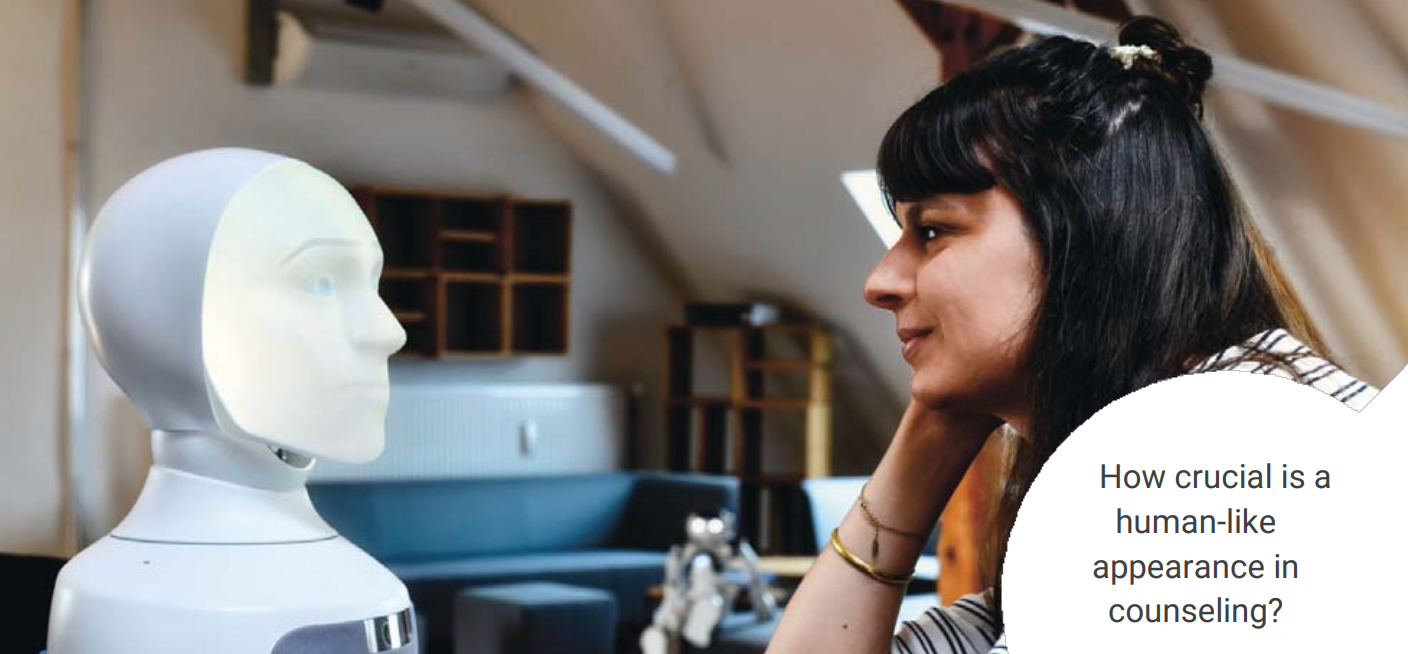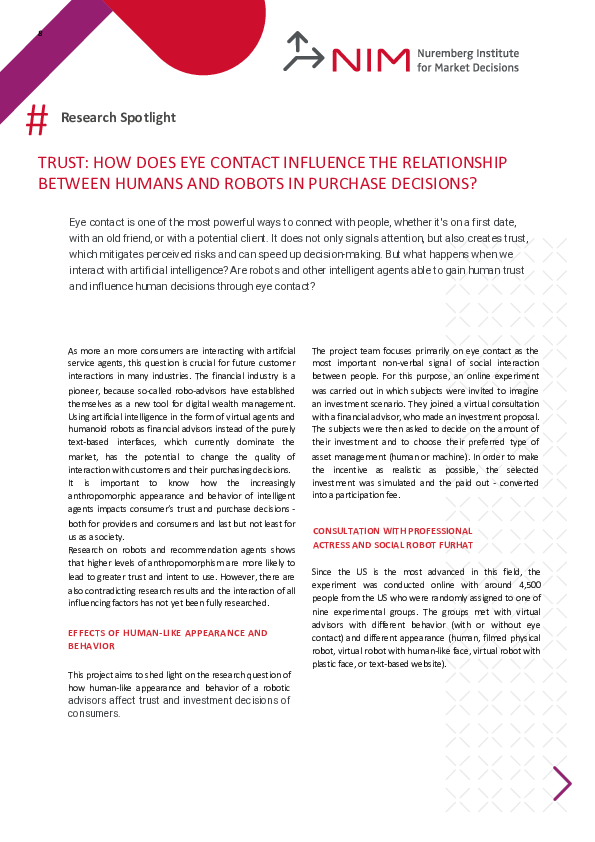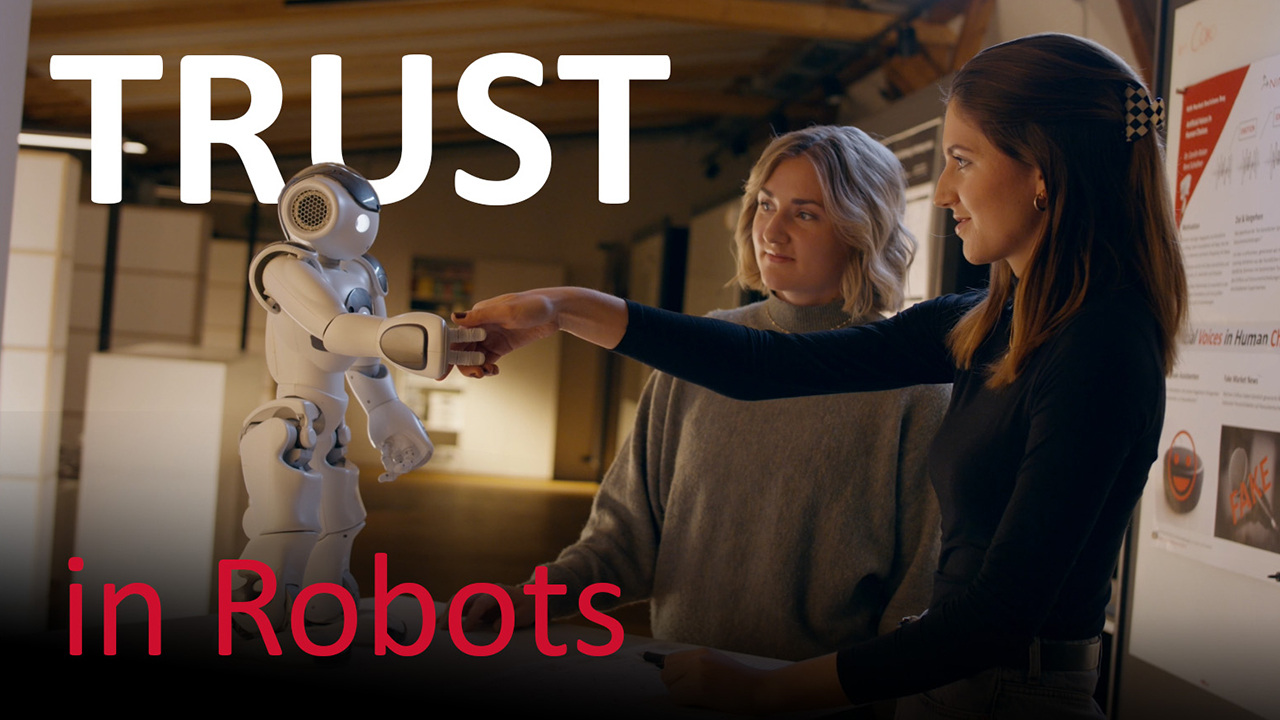Research
Trust: How Does Eye Contact Influence the Relationship Between Humans and Robots in Purchase Decisions?
Eye contact is one of the most effective ways to establish contact and rapport with people – whether on a first date, with an old friend, or with potential customers. It does not only signal attention but also builds trust. Both of these mitigate perceived risks and can speed up decision-making. But what happens when we interact with artificial intelligence? Are robots and other intelligent agents able to gain human trust and influence human decisions through eye contact?

With the increasing use of intelligent agents in interactions with consumers, this question is of crucial importance for future customer interaction in many industries. The financial industry is a pioneer because so-called robo-advisors have established themselves as a new tool for digital asset management. The use of artificial intelligence in the form of virtual agents and humanoid robots as financial advisors, rather than the purely text-based interfaces that currently dominate the market, has the potential to change the quality of interaction with customers and their purchasing decisions. The question of what effect the increasingly anthropomorphic appearance of intelligent agents has on customers’ trust in the advice and financial products offered is important for providers, consumers, and also us as a society. Research on robots and recommendation agents shows that higher levels of anthropomorphism tend to lead to greater trust and increased intent to use. However, there are also conflicting research findings, and the interplay of all influencing factors has not yet been fully investigated.
Key Findings
- The humanlike appearance of the consultant is crucial when it comes to trust and decision satisfaction.
- Virtual social robots are considered more trustworthy than robo-advisors based on purely text-based websites.
- Eye contact matters – even with robots. For developers of human–robot interactions, this means paying attention to eye contact with consumers is important. Consumers should be aware that advice from more “human” artificial intelligence may also lead to more willingness to follow its recommendations.
Effects of Different Humanlike Appearance and Behavior
This project aims to shed light on the research question of how different humanlike appearances and behaviors of a robot advisor affect consumer trust and investment decisions. The project team focuses primarily on eye contact as the most important nonverbal signal of social interaction between humans. To this end, an online experiment was conducted in which test subjects were invited to deal with the topic of investing money. They had a virtual consultation with a financial advisor, who also made an investment proposal. Afterward, the test subjects were asked to decide on the amount of their investment and the type of asset management (human or machine). To make the incentive as realistic as possible, the chosen investment was simulated and paid out – converted into a participation fee.
Consulting With a Professional Actress and Social Robot Furhat
As robo-advisors are already widely used in the U.S., the experiment was conducted online with around 4,500 people from the U.S. who were randomly distributed into one of nine experimental groups. The groups differed in the conditions of “eye contact of the financial advisor” (with and without eye contact) and “design of the financial advisor,” in which the categories human, filmed physical robot, virtual robot with humanlike face, virtual robot with plastic face, and simple website were used. The consulting sessions were realized with a professional actress and the fully programmable social robot Furhat. Typical speech segments of a financial consultation were filmed and then put together to form a seamless virtual consultation dialogue. In the questionnaire, participants provided information on their perceptions of financial advice, their own reactions and decisions, and their technical, financial, and sociodemographic backgrounds.
Trust in Robots
Humanlike Appearance Makes the Difference
The results show that the humanlike appearance of the advisor is crucial. Robots were trusted less than humans, but compared to the text-based website, the robots led to a better assessment of the relevance of the recommendation, higher satisfaction with their own decision, greater overall satisfaction, and a higher likelihood of choosing the machine-managed investment.
It also becomes clear that eye contact with robots has a smaller but similar effect as eye contact with a human advisor – yet is essential for trust and satisfaction. Participants who had eye contact with a robot advisor rated the advisor as more competent, felt a higher level of trust in the advisor, liked the advisor more, were more satisfied overall, and were more willing to recommend the advisor to others. However, eye contact alone does not immediately lead to higher investments. There is only an indication of a weak indirect coherence as eye contact increases trust, and higher trust, along with increased risk affinity, goes hand in hand with higher investments.
Providers, including those in other industries, have the opportunity to use the new technology to increase the perceived quality of their touchpoints with their consumers when compared to text-based agents. Consumers should be aware that they tend to respond to anthropomorphic artificial intelligence with more trust – and possibly more willingness to follow advice – and take this into account when making decisions. For a fact-based and constructive sociopolitical discourse on the future role of artificial intelligence, it is important to know the possibilities and limits of supporting and manipulating human consumption decisions.
Project team
- Dr. Carolin Kaiser, Head of Artificial Intelligence, NIM, carolin.kaiser@nim.org
- René Schallner
Contact


![[Translate to English:] [Translate to English:]](/fileadmin/_processed_/1/2/csm_CK_NIM_01_58bed63910.png)